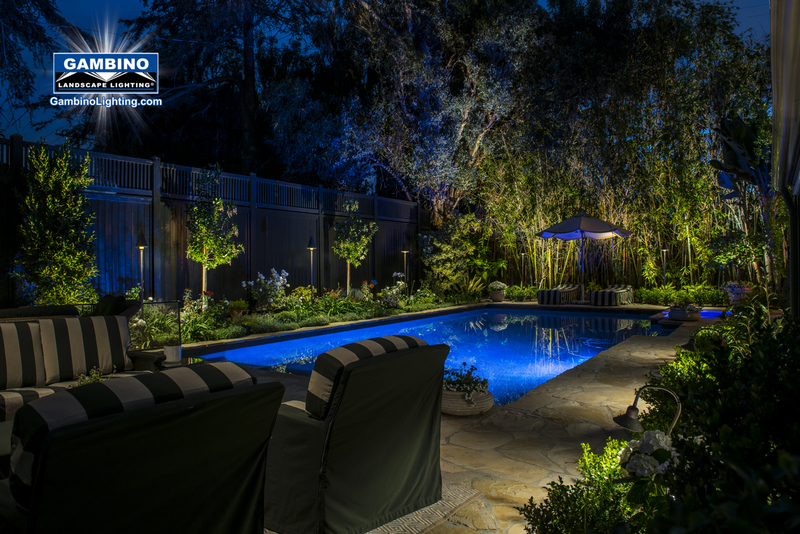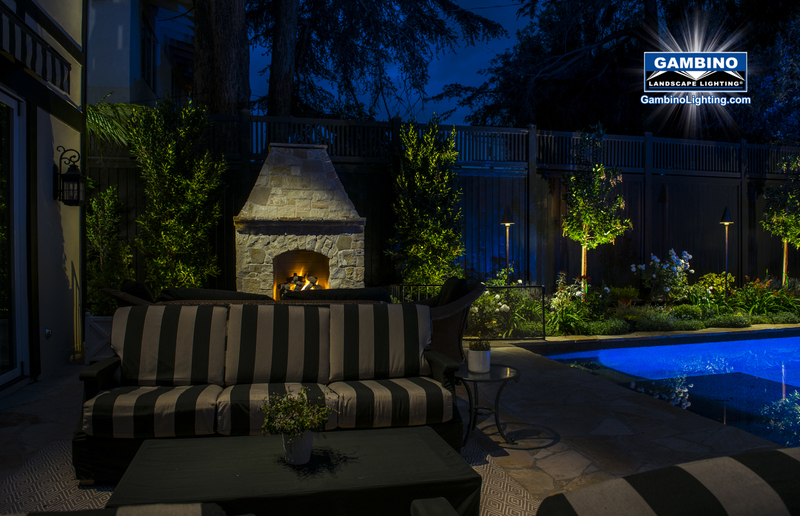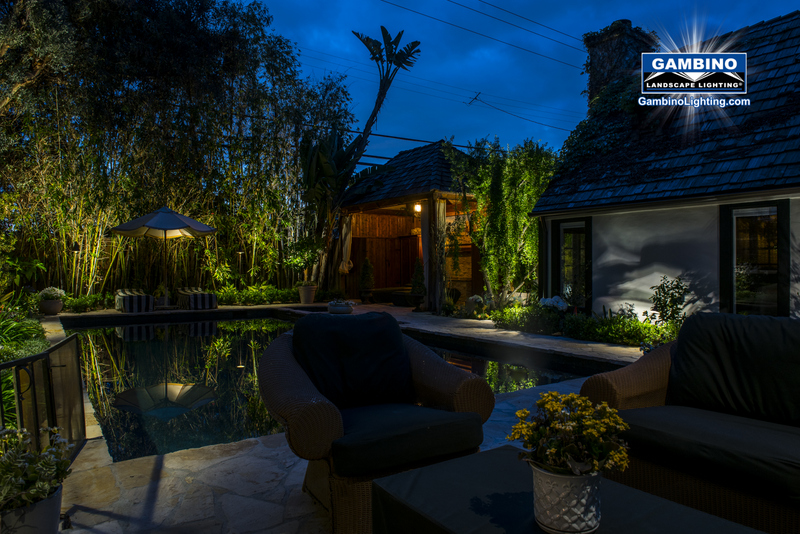07 Feb With Landscape Lighting system construction, there are many degrees of quality based on cost
By Mike Gambino
Don’t think of it as someone trying to rip you off or take advantage of you. Think of it more as you get what you pay for. Just like when you shop for a car, furniture, or a quality suit and pair of shoes, at first glance, those items don’t always look that different from the top-of-the-line versions. But after careful examination, there are big differences.
With new landscape lighting system build construction, there are many degrees of quality based on affordability. You need to know what your priorities are: Quantity or quality or Both? If your budget is limited do you prefer a complete system with corners cut during the installation using cheaper products to meet what you desire to pay?
 Or a better-built system that will be high performing, lower maintenance and stand the rigors of the outdoor environment using quality materials and sound installation techniques built on a smaller part of the property with plans to expand as budget permits? Or are you willing to “bite the bullet” and dedicate the appropriate budget to avoid hassles to do the entire job correctly the first and only time? If you are one of these two types of buyer then you would be the type of client that my company Gambino landscape lighting serves.
Or a better-built system that will be high performing, lower maintenance and stand the rigors of the outdoor environment using quality materials and sound installation techniques built on a smaller part of the property with plans to expand as budget permits? Or are you willing to “bite the bullet” and dedicate the appropriate budget to avoid hassles to do the entire job correctly the first and only time? If you are one of these two types of buyer then you would be the type of client that my company Gambino landscape lighting serves.
Some landscape lighting builders have mastered how to build for less by minimizing installation techniques and using lesser quality, lower cost products, which are very expensive to the unsuspecting property owner over time.
It begins with a property owner who has an unrealistic expectation of cost who has been doing a little research then contacts a professional landscape lighting design build specialist to design and install a system. Perhaps they have seen fixtures in their local home improvement store or on the internet and based on the low cost of these inferior quality products derive a general idea of what they believe it should cost for a pro to install a system on their property. The pro presents the price and the owner is blown away and has sticker shock. Believing they are getting ripped off they call another and then perhaps another service provider until they usually end up with someone who will install for what they want to spend even if this means the owner buying the equipment themselves and having a laborer, their gardener, landscaper or handyman install it. Respectfully I call this scenario the blind leading the blind.
Contrary to what these types of buyers may believe, a custom built to last and perform landscape lighting system is a lot more than just the some of its parts. It’s not just a matter of buying transformers, wire , LED’s, fixtures and just sticking them in the ground. The 3 most important aspects of a successful and high performing system are:
1-The original design
2-The technical aspect of the installation
3-The quality of the products used.
It is these three main areas where things can go awry real fast when a unsuspecting property owner goes the cheaper route.
Design– Landscape Lighting designers that specialize are expert in optimizing clients budgets and expectations. They determine the best product types, quantities and placements to achieve the best effect for their applications. Choosing the best light sources, which currently are LED lamps. Specifying the light color, brightness, beam spreads-tight spot, narrow spot, narrow flood, medium flood, wide flood etc. are crucial to the successful outcome of your project.
Technical Installation– Building the system with the latest and most quality/cost efficient build techniques so it is easier to maintain, easier to modify as the garden grows, evolves and changes overtime. Today’s newly planted garden looks much different in 2 years, 5 years, 10 years etc. Systems must be built with this fluidity in mind.
Products– Specification of Higher performing and adjustable components for best effect, built solid to withstand the stresses and rigors of the outdoor environment, Resistant to water intrusion, Holds lamps in place firmly and in focus.
The first way to save money is by hiring non specialized trades who are not lighting designers and they don’t know what they don’t know. It is not their primary and only trade so it cannot and does not get their full attention. They do not focus on staying up to date with the latest trends and best practices being used by specialists in the trade. Because they are trying to save you money this will require using lesser fixture quantities with brighter lamps to compensate. This typically results in excessive glare to the viewer because the best aiming positions and angles cannot be achieved. High contrast between lighted and not lighted areas that is not result by any means in an aesthetically pleasing way. There are not enough fixtures to create lighting layers or transitional lighting to bridge focal points with areas that are intended to be downplayed in the garden. Hot spots that appear overly bright areas and extremely dark areas that can be unsafe and make the overall scheme appear spotty with the eye darting between the brightest illuminated areas and not smoothly and pleasingly over the entire scene.
Another way builders can cut costs is by placing wiring and cable inside of sprinkler trenches or worse yet leaving them exposed above ground or covering power cable with mulch to avoid the labor intense or digging and risk of damage to previously buried utilities. The problem with installing it together in sprinkler trenches is that it becomes susceptible to being cut when sprinkler components need to be dug up for maintenance or repair or when plants are removed or newly planted.
I don’t think I need to mention the problems that can occur by not burying power wire and cable. Electrical wiring is far more expensive when placed in rigid conduit and buried to a proper depth than direct burial low voltage cable material, which is acceptable by code by the way however never recommended by this author.
 Money can be initially saved by installers using old and no longer recommended wiring methods such as “the loop” and or the “daisy chain”. Both methods do not efficiently or properly distribute power equally to all lamps which results in not providing manufacturer recommended voltage to the lamp which can result in unpredictable light outputs and a decrease in lamp life and longevity. An excess use of electrical power is also a factor that results in higher cost of operation throughout the lifetime of the system.
Money can be initially saved by installers using old and no longer recommended wiring methods such as “the loop” and or the “daisy chain”. Both methods do not efficiently or properly distribute power equally to all lamps which results in not providing manufacturer recommended voltage to the lamp which can result in unpredictable light outputs and a decrease in lamp life and longevity. An excess use of electrical power is also a factor that results in higher cost of operation throughout the lifetime of the system.
Lower cost systems do not use the best wiring methodology which is the spoke and hub wiring method with all wire and cable installed inside of properly rated rigid electrical conduit and burying it to a depth of 10-12″ for the mains and 4-6″ on the secondary. The spoke and hub method is where main cables from the power source transformers go to multiple lighting areas of the property to hubs or satellite Junction boxes that are centrally located to the fixtures that they power. Then conduits and cable are distributed out from the hubs to power the fixtures like spokes on a wheel. These hubs all link to each other and back to the power source transformers for easier future maintenance or repairs should the need be or for system modifications or expansion.
 Reducing fixture and lamp quantities can reduce cost tremendously, and prefabricated mass produced fixtures to custom batches made in small quantities. Material can range from common construction grade steel and aluminum metals which are painted or coated to slow down corrosion to expensive AAA-grade brass and copper with an expensive hand-rubbed stain and hand-brushed finishes.
Reducing fixture and lamp quantities can reduce cost tremendously, and prefabricated mass produced fixtures to custom batches made in small quantities. Material can range from common construction grade steel and aluminum metals which are painted or coated to slow down corrosion to expensive AAA-grade brass and copper with an expensive hand-rubbed stain and hand-brushed finishes.
Even Brass or copper fixtures, both solid and engineered, can be of many qualities and varieties, from casted in a tool or mold solid material, to less expensive lighter walled spun on a lathe or punched-manufactured or copper or brass coated non ferrous metal (rust) fixtures.
Is the mount or stake that secures the fixture brass or thick PVC, which is a reliable hard plastic and cemented in the ground so they stay straight and don’t shift? Needless to say, the brass will last longer but is much more expensive, and rarely visible to the owner so it’s an area that can easily be skimped on by using light plastics to save cost.
A little research on landscape lighting products including transformers, fixtures, LED lamps make the price and quality differences very clear.
Learn to differentiate between the standard and the high-quality products. Not only do they look different but their durability and life expectancy are also different.
 If you are building a home from scratch or remodeling a landscape, you will need to decide where your priorities lie. Staying on budget is always the biggest challenge. At the very least pay to have a knowledgeable custom landscape lighting design specialist explain the quality of construction and where weakness might cause potential problems in the future. If the budget doesn’t permit to immediately install the lighting it pays to have both the high and low voltage infrastructure built and put in place during the landscape construction phase. Sleeving and all conduits installed while the yard is dug up saves owners significant money, future disruption and damage to the landscaping and becomes an inspiration and proper foundation for the hardware to be installed later.
If you are building a home from scratch or remodeling a landscape, you will need to decide where your priorities lie. Staying on budget is always the biggest challenge. At the very least pay to have a knowledgeable custom landscape lighting design specialist explain the quality of construction and where weakness might cause potential problems in the future. If the budget doesn’t permit to immediately install the lighting it pays to have both the high and low voltage infrastructure built and put in place during the landscape construction phase. Sleeving and all conduits installed while the yard is dug up saves owners significant money, future disruption and damage to the landscaping and becomes an inspiration and proper foundation for the hardware to be installed later.
Never sacrifice on Design, Installation and Products. These three areas need to be perfect. Always do your research and due diligence, ask for referrals, check reviews and designers past work before making any decisions. Only call a reliable and professional specialized service provider for best landscape lighting results.
 This landscape lighting blog is published by Mike Gambino of Gambino landscape lighting inc. all rights reserved. Mike is
This landscape lighting blog is published by Mike Gambino of Gambino landscape lighting inc. all rights reserved. Mike is a professional landscape lighting system designer/ builder and has been designing, installing and maintaining landscape lighting systems for more than 30 years. Mike resides in the Los Angeles area with his wife and 2 sons. To visit his website go to www.Gambinolighting.com . To inquire about hiring Mike please click here .
a professional landscape lighting system designer/ builder and has been designing, installing and maintaining landscape lighting systems for more than 30 years. Mike resides in the Los Angeles area with his wife and 2 sons. To visit his website go to www.Gambinolighting.com . To inquire about hiring Mike please click here .
Blog articles may be published with permission on other websites without editing or removing links.



No Comments